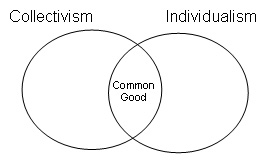| Social Studies – Grade 12 | Close this window |
 |
Ideology and Identity (OCI) > Are Collectivism and Individualism Opposites? (CC) |
  |
What's this? |
Are Collectivism and Individualism Opposites?
Create a visual representation that accurately illustrates the relationships among individualism, collectivism and the common good.
|
||||
 |
||||
Suggested ActivitiesStudents assess the extent to which individualism and collectivism promote the common good by deciding how best to represent, visually, the relationships between these concepts based on an examination of various individual and collective actions. Introduce key concepts Provide students with examples of the concepts of collectivism and individualism, indicating that both collectivists and individualists believe that their ideology best serves the common good. Develop a common working understanding of each concept. The following statements and questions could be posed to assess student understanding of the concepts:
Invite students to consider the degree to which the principles/values of individualism oppose the principles/values of collectivism and the degree to which, if any, they share common ideals. Rank actions that reflect collectivist or individualist principles or values Ask students to rank each action on a scale of 1 to 5 where 1 represents “only individualist principles” (values in 30-2) and 5 represents “only collectivist principles” (values in 30-2). To start the discussion, provide this list of actions:
After students complete the ranking process, ask them to share and discuss the placement of each of the actions. Develop common understandings for each concept. Following this discussion, invite students to make changes to their rankings to reflect new understandings of the concepts. Use a Venn diagram to represent relationships among concepts
In addition, or alternatively, students could write statements summarizing the relationships. For additional information, see Venn Diagrams (Support Material). Create a visual representation Suggest to students that criteria for a visual representation should include the following:
You may want to refer to the criteria and guidelines for effective visual presentations found in Creating Persuasive and Effective Visuals (Modelling the Tools). In addition, you may want to refer to Justifying My Choice (Support Material) to help students present ideas and consider other perspectives. |
||||
 |



